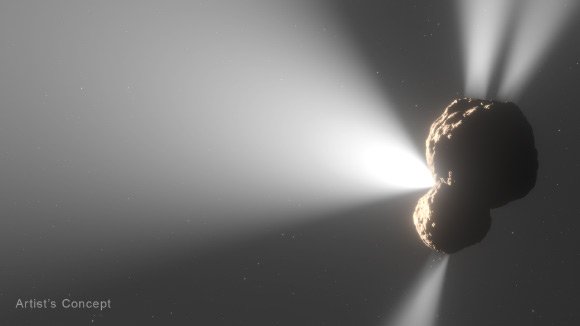Centaurs are former trans-Neptunian objects that have been moved inside Neptune’s orbit by subtle gravitational influences of the planets in the last few million years, and may eventually become short-period comets.
An artist’s concept of 29P/Schwassmann-Wachmann 1’s outgassing activity as seen from the side. Image credit: NASA / ESA / CSA / L. Hustak, STScI.
Centaurs are transitional objects between primitive trans-Neptunian objects and Jupiter-family comets.
Their compositions and activities provide fundamental clues regarding the processes affecting the evolution of and interplay between these small bodies.
“Centaurs can be considered as some of the leftovers of our planetary system’s formation,” said Dr. Sara Faggi, a researcher at NASA’s Goddard Space Flight Center and American University.
“Because they are stored at very cold temperatures, they preserve information about volatiles in the early stages of the Solar System.”
“Webb really opened the door to a resolution and sensitivity that was impressive to us — when we saw the data for the first time, we were excited. We had never seen anything like this.”
Using Webb’s NIRSpec (Near-Infrared Spectrograph) instrument, Dr. Faggi and her colleagues observed 29P/Schwassmann-Wachmann 1 (29P for short), a centaur that is known for its highly active and quasi-periodic outbursts.
29P varies in intensity every six to eight weeks, making it one of the most active objects in the outer Solar System.
They discovered a new jet of carbon monoxide and previously unseen jets of carbon dioxide gas, which give new clues to the nature of the centaur’s nucleus.
No indication of water vapor was detected in the ‘atmosphere’ of 29P, which could be related to the extremely cold temperatures present in this body.
Based on the data gathered by Webb, the researchers created a 3D model of the jets to understand their orientation and origin.
They found through their modeling efforts that the jets were emitted from different regions on the centaur’s nucleus, even though the nucleus itself cannot be resolved by Webb.
The jets’ angles suggest the possibility that the nucleus may be an aggregate of distinct objects with different compositions; however, other scenarios can’t yet be excluded.
Faggi et al. used Webb’s spectrographic capabilities to gather data on 29P/Schwassmann-Wachmann 1. Image credit: NASA / ESA / CSA / L. Hustak, STScI / S. Faggi, NASA’s Goddard Space Flight Center & American University.
“The fact that 29P has such dramatic differences in the abundance of carbon monoxide and carbon dioxide across its surface suggests that 29P may be made of several pieces,” said Dr. Geronimo Villanueva, a researcher at NASA’s Goddard Space Flight Center.
“Maybe two pieces coalesced together and made this centaur, which is a mixture between very different bodies that underwent separate formation pathways.”
“It challenges our ideas about how primordial objects are created and stored in the Kuiper Belt.”
The reasons for 29P’s bursts in brightness, and the mechanisms behind its outgassing activity through the carbon monoxide and carbon dioxide jets, continue to be two major areas of interest that require further investigation.
In the case of comets, scientists know that their jets are often driven by the outgassing of water.
However, because of the centaurs’ location, they are too cold for water ice to sublimate, meaning that the nature of their outgassing activity differs from comets.
“We only had time to look at this object once, like a snapshot in time,” said Dr. Adam McKay, a researcher at Appalachian State University.
“I’d like to go back and look at 29P over a much longer period of time. Do the jets always have that orientation? Is there perhaps another carbon monoxide jet that turns on at a different point in the rotation period?”
“Looking at these jets over time would give us much better insights into what is driving these outbursts.”
The team’s paper was published in the journal Nature.
_____
S. Faggi et al. Heterogeneous outgassing regions identified on active centaur 29P/Schwassmann-Wachmann 1. Nat Astron, published online July 8, 2024; doi: 10.1038/s41550-024-02319-3
This article is a version of a press-release provided by NASA.
Discover more from CaveNews Times
Subscribe to get the latest posts sent to your email.


























![Exploring the Serene Beauty of Nature: A Reflection on [YouTube video title]](https://cavemangardens.art/storage/2024/04/114803-exploring-the-serene-beauty-of-nature-a-reflection-on-youtube-video-title-360x180.jpg)




























